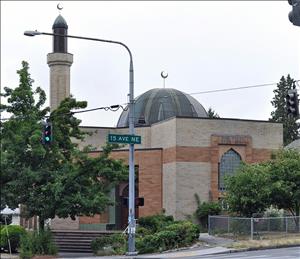In 1981, the Sheihk Idriss Mosque is built in Seattle's north end, near the Northgate shopping mall. It is Seattle's first mosque, and the first mosque west of the Mississippi River to be built in a Middle Eastern design. A key participant in the building is Jamil Abdul Razzak Hajoo, who arrived in the region in the 1950s to work as a mechanic at Boeing, and who in 1974 helped found the first Muslim gathering place in the region, in Burien.
There were difficulties in building the mosque in the midst of hostility in the community stirred up by the Iranian hostage crisis. "Our neighbors were upset," Abdul-Razzak told a reporter in 1986. "They went to court with petitions to stop us. They didn't know what kind of people we were and they were very upset over the hostages. We won the court case but the neighbors appealed. It dragged on for a year" (John Wolcott).
During the litigation, interest rates were going up and the cost of construction spiraled from $300,000 to $800,000. Funds for the building were donated by Saudi Arabian Sheik Abdel-Keder Idriss. When the project was completed the congregants invited the neighbors for coffee and cake and to show them the beautiful building. Abdul-Razzak remembered, "They were very nice. Many of them felt bad about how they had treated us" (John Wolcott).
The architect was Dennis Alkire (Mithun Associates). Of the mosque one writer notes:
"Clear-cut volumetric composition is one of the building's chief attributes; through careful massing the small building apears much larger and assumes a public importance unusual for its size .... The mosque's most notable features are an octagonal dome and a symbolic minaret, both sheathed in copper and capped with crescent moons. The red brick walls are banded with buff brick and pierced by tall glass-block windows, which are topped with concrete lintels in the shape of Moorish arches. An abundance of brass, copper, and celadon green ceramic tile highlight and define the main entry. Two tile benches which flank the entry are a traditional element of Islamic hospitality, a welcoming gesture perceived by any culture" (David Schraer).
As David Buerge and Junius Rochester write, "The mosque with its tall brick minaret near Seattle’s Northgate shopping mall is one more visual example of how religion serves to create a sense of community."
The mosque is located at 11004 14th Avenue NE near Northgate Way.

